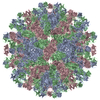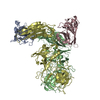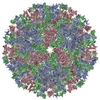[English] 日本語
 Yorodumi
Yorodumi- EMDB-61527: Cryo-EM structure of a T=1 VLP of RHDV GI.2 with N-terminal 1-37 ... -
+ Open data
Open data
- Basic information
Basic information
| Entry |  | |||||||||||||||
|---|---|---|---|---|---|---|---|---|---|---|---|---|---|---|---|---|
| Title | Cryo-EM structure of a T=1 VLP of RHDV GI.2 with N-terminal 1-37 residues truncated | |||||||||||||||
 Map data Map data | ||||||||||||||||
 Sample Sample |
| |||||||||||||||
 Keywords Keywords | Calicivirus / viral assembly / rabbit hemorrhagic disease virus (RHDV) / major capsid protein / virus-like particle / VIRUS / VIRUS LIKE PARTICLE | |||||||||||||||
| Function / homology | Calicivirus coat protein / Calicivirus coat protein / virion component / Picornavirus/Calicivirus coat protein / Viral coat protein subunit / host cell cytoplasm / Capsid protein Function and homology information Function and homology information | |||||||||||||||
| Biological species |  Rabbit hemorrhagic disease virus 2 Rabbit hemorrhagic disease virus 2 | |||||||||||||||
| Method | single particle reconstruction / cryo EM / Resolution: 2.4 Å | |||||||||||||||
 Authors Authors | Ruan Z / Shao Q / Song Y / Hu B / Fan Z / Wei H / Liu Y / Wang F / Fang Q | |||||||||||||||
| Funding support |  China, 4 items China, 4 items
| |||||||||||||||
 Citation Citation |  Journal: J Virol / Year: 2024 Journal: J Virol / Year: 2024Title: Near-atomic structures of RHDV reveal insights into capsid assembly and different conformations between mature virion and VLP. Authors: Zhiyang Ruan / Qianqian Shao / Yanhua Song / Bo Hu / Zhiyu Fan / Houjun Wei / Yunshu Liu / Fang Wang / Qianglin Fang /  Abstract: Rabbit hemorrhagic disease virus (RHDV) poses a significant threat to rabbits, causing substantial economic losses in rabbit farming. The virus also endangers wild populations of rabbit species and ...Rabbit hemorrhagic disease virus (RHDV) poses a significant threat to rabbits, causing substantial economic losses in rabbit farming. The virus also endangers wild populations of rabbit species and the predatory animals that rely on rabbits as a food source, thereby disturbing the ecological balance. However, the structural understanding of RHDV has been limited due to the lack of high-resolution structures. Here, we present the first high-resolution cryo-EM structures of the mature virion and virus-like particles (VLPs) derived from both full-length and N-terminal arm (NTA)-truncated VP60. These structures reveal intricate structural details of the icosahedral capsid and crucial NTA-mediated interactions essential for capsid assembly. In addition, dramatic conformational differences are unexpectedly observed between the mature virion and VLP. The protruding spikes of the A-B dimers adopt a "raised" state in the mature virion and a "resting" state in the VLP. These findings enhance our understanding of the structure, assembly, and conformational dynamics of the RHDV capsid, laying the essential groundwork for further virological research and therapeutic advancements.IMPORTANCERHDV is a pathogen with significant economic and ecological impact. By presenting the first high-resolution cryo-EM structures of RHDV, we have uncovered detailed interactions among neighboring VP60 subunits of the icosahedral capsid. The NTA of VP60 is uniquely clustered around the threefold axis of the capsid, probably play a critical role in dragging the six VP60 dimers around the threefold axis during capsid assembly. Additionally, we observed dramatic conformational differences between the mature virion and VLPs. VLPs are commonly used for vaccine development, under the assumption that their structure closely resembles that of the mature virion. Our findings significantly advance the understanding of the RHDV capsid structure, which may be used for developing potential therapeutic strategies against RHDV. | |||||||||||||||
| History |
|
- Structure visualization
Structure visualization
| Supplemental images |
|---|
- Downloads & links
Downloads & links
-EMDB archive
| Map data |  emd_61527.map.gz emd_61527.map.gz | 287.8 MB |  EMDB map data format EMDB map data format | |
|---|---|---|---|---|
| Header (meta data) |  emd-61527-v30.xml emd-61527-v30.xml emd-61527.xml emd-61527.xml | 17.2 KB 17.2 KB | Display Display |  EMDB header EMDB header |
| FSC (resolution estimation) |  emd_61527_fsc.xml emd_61527_fsc.xml | 15.2 KB | Display |  FSC data file FSC data file |
| Images |  emd_61527.png emd_61527.png | 172.2 KB | ||
| Masks |  emd_61527_msk_1.map emd_61527_msk_1.map | 307.5 MB |  Mask map Mask map | |
| Filedesc metadata |  emd-61527.cif.gz emd-61527.cif.gz | 6.1 KB | ||
| Others |  emd_61527_half_map_1.map.gz emd_61527_half_map_1.map.gz emd_61527_half_map_2.map.gz emd_61527_half_map_2.map.gz | 246.8 MB 246.8 MB | ||
| Archive directory |  http://ftp.pdbj.org/pub/emdb/structures/EMD-61527 http://ftp.pdbj.org/pub/emdb/structures/EMD-61527 ftp://ftp.pdbj.org/pub/emdb/structures/EMD-61527 ftp://ftp.pdbj.org/pub/emdb/structures/EMD-61527 | HTTPS FTP |
-Validation report
| Summary document |  emd_61527_validation.pdf.gz emd_61527_validation.pdf.gz | 985.2 KB | Display |  EMDB validaton report EMDB validaton report |
|---|---|---|---|---|
| Full document |  emd_61527_full_validation.pdf.gz emd_61527_full_validation.pdf.gz | 984.8 KB | Display | |
| Data in XML |  emd_61527_validation.xml.gz emd_61527_validation.xml.gz | 23 KB | Display | |
| Data in CIF |  emd_61527_validation.cif.gz emd_61527_validation.cif.gz | 30.5 KB | Display | |
| Arichive directory |  https://ftp.pdbj.org/pub/emdb/validation_reports/EMD-61527 https://ftp.pdbj.org/pub/emdb/validation_reports/EMD-61527 ftp://ftp.pdbj.org/pub/emdb/validation_reports/EMD-61527 ftp://ftp.pdbj.org/pub/emdb/validation_reports/EMD-61527 | HTTPS FTP |
-Related structure data
| Related structure data |  9jjhMC  9jjgC  9jjiC  9jjjC M: atomic model generated by this map C: citing same article ( |
|---|---|
| Similar structure data | Similarity search - Function & homology  F&H Search F&H Search |
- Links
Links
| EMDB pages |  EMDB (EBI/PDBe) / EMDB (EBI/PDBe) /  EMDataResource EMDataResource |
|---|---|
| Related items in Molecule of the Month |
- Map
Map
| File |  Download / File: emd_61527.map.gz / Format: CCP4 / Size: 307.5 MB / Type: IMAGE STORED AS FLOATING POINT NUMBER (4 BYTES) Download / File: emd_61527.map.gz / Format: CCP4 / Size: 307.5 MB / Type: IMAGE STORED AS FLOATING POINT NUMBER (4 BYTES) | ||||||||||||||||||||||||||||||||||||
|---|---|---|---|---|---|---|---|---|---|---|---|---|---|---|---|---|---|---|---|---|---|---|---|---|---|---|---|---|---|---|---|---|---|---|---|---|---|
| Projections & slices | Image control
Images are generated by Spider. | ||||||||||||||||||||||||||||||||||||
| Voxel size | X=Y=Z: 1.074 Å | ||||||||||||||||||||||||||||||||||||
| Density |
| ||||||||||||||||||||||||||||||||||||
| Symmetry | Space group: 1 | ||||||||||||||||||||||||||||||||||||
| Details | EMDB XML:
|
-Supplemental data
-Mask #1
| File |  emd_61527_msk_1.map emd_61527_msk_1.map | ||||||||||||
|---|---|---|---|---|---|---|---|---|---|---|---|---|---|
| Projections & Slices |
| ||||||||||||
| Density Histograms |
-Half map: #2
| File | emd_61527_half_map_1.map | ||||||||||||
|---|---|---|---|---|---|---|---|---|---|---|---|---|---|
| Projections & Slices |
| ||||||||||||
| Density Histograms |
-Half map: #1
| File | emd_61527_half_map_2.map | ||||||||||||
|---|---|---|---|---|---|---|---|---|---|---|---|---|---|
| Projections & Slices |
| ||||||||||||
| Density Histograms |
- Sample components
Sample components
-Entire : Rabbit hemorrhagic disease virus 2
| Entire | Name:  Rabbit hemorrhagic disease virus 2 Rabbit hemorrhagic disease virus 2 |
|---|---|
| Components |
|
-Supramolecule #1: Rabbit hemorrhagic disease virus 2
| Supramolecule | Name: Rabbit hemorrhagic disease virus 2 / type: virus / ID: 1 / Parent: 0 / Macromolecule list: all / NCBI-ID: 1930083 / Sci species name: Rabbit hemorrhagic disease virus 2 / Virus type: VIRION / Virus isolate: STRAIN / Virus enveloped: No / Virus empty: Yes |
|---|---|
| Virus shell | Shell ID: 1 / Diameter: 290.0 Å / T number (triangulation number): 1 |
-Macromolecule #1: Capsid protein
| Macromolecule | Name: Capsid protein / type: protein_or_peptide / ID: 1 / Number of copies: 1 / Enantiomer: LEVO |
|---|---|
| Source (natural) | Organism:  Rabbit hemorrhagic disease virus 2 / Strain: GI.2 Rabbit hemorrhagic disease virus 2 / Strain: GI.2 |
| Molecular weight | Theoretical: 56.900066 KDa |
| Recombinant expression | Organism:  |
| Sequence | String: TSVVTTENAS TSIATAGIGG PPQQMDQQET WRTNFYYNDV FTWSVADAPG NILYTVQHSP QNNPFTAVLS QMYAGWAGGM QFRFIVAGS GVFGGRLVAA VIPPGIEIGP GLEVRQFPHV VIDARSLEPV TITMPDLRPN MYHPTGNPGL VPTLVLSVYN N LINPFGGS ...String: TSVVTTENAS TSIATAGIGG PPQQMDQQET WRTNFYYNDV FTWSVADAPG NILYTVQHSP QNNPFTAVLS QMYAGWAGGM QFRFIVAGS GVFGGRLVAA VIPPGIEIGP GLEVRQFPHV VIDARSLEPV TITMPDLRPN MYHPTGNPGL VPTLVLSVYN N LINPFGGS TSAIQVTVET RPSEDFEFVM IRAPSSKTVD SISPADLLTT PVLTGVGTDN RWNGEIVGLQ PVPGGFSTCN RH WNLNGST YGWSSPRFAA IDHDRGNASF PGSSSSNVLE LWYASAGSAA DNPISQIAPD GFPDMSFVPF SGITIPTAGW VGF GGIWNS SNGAPYVTTM QAYELGFATG VPSNPQPTTT TSGAQIVAKS IYGVANGINQ TTAGLFVMAS GVISTPNSSA TTYT PQPNR IVNAPGTPAA APIGKNTPIM FASVVRRTGD INAEAGSTNG TQYGAGSQPL PVTIGLSLNN YSSALMPGQF FVWQL NFAS GFMELGLSVD GYFYAGTGAS ATLIDLSDLV DIRPVGPRPS TSTLVYNLGG TTNGFSYV UniProtKB: Capsid protein |
-Experimental details
-Structure determination
| Method | cryo EM |
|---|---|
 Processing Processing | single particle reconstruction |
| Aggregation state | particle |
- Sample preparation
Sample preparation
| Buffer | pH: 7.2 |
|---|---|
| Grid | Model: Quantifoil R2/1 / Material: COPPER / Support film - Material: CARBON / Support film - topology: CONTINUOUS / Pretreatment - Type: GLOW DISCHARGE |
| Vitrification | Cryogen name: ETHANE / Instrument: FEI VITROBOT MARK IV |
- Electron microscopy
Electron microscopy
| Microscope | FEI TITAN KRIOS |
|---|---|
| Image recording | Film or detector model: FEI FALCON IV (4k x 4k) / Number real images: 112 / Average exposure time: 5.09 sec. / Average electron dose: 26.09 e/Å2 |
| Electron beam | Acceleration voltage: 300 kV / Electron source:  FIELD EMISSION GUN FIELD EMISSION GUN |
| Electron optics | C2 aperture diameter: 70.0 µm / Illumination mode: FLOOD BEAM / Imaging mode: BRIGHT FIELD / Cs: 2.7 mm / Nominal defocus max: 3.0 µm / Nominal defocus min: 1.0 µm / Nominal magnification: 59000 |
| Sample stage | Specimen holder model: FEI TITAN KRIOS AUTOGRID HOLDER / Cooling holder cryogen: NITROGEN |
| Experimental equipment |  Model: Titan Krios / Image courtesy: FEI Company |
 Movie
Movie Controller
Controller







 Z (Sec.)
Z (Sec.) Y (Row.)
Y (Row.) X (Col.)
X (Col.)













































